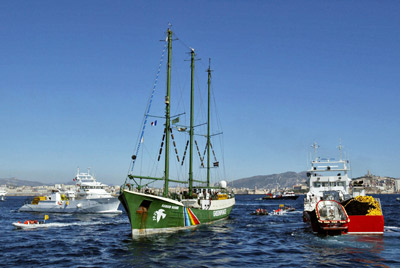Canadians joke that if you walk into any Vancouver bar, you're sure to meet a Greenpeace founder. But while many early members shaped Greenpeace into the NGO it is today, the organization had seven primary founders. The original group began its protests in 1971 when the United States announced a plan to detonate a nuclear test bomb on Amchitka Island, off the coast of Alaska. Canadians opposed the idea not only because the five megaton bomb would contaminate the island and harm the otters, bald eagles and peregrine falcons that lived there, but also because the explosion had the potential to create a tidal wave. In reference to the impending threat of a tidal wave, the Vancouver group called itself the Don't Make a Wave Committee.
The group soon gained the support of the Sierra Club and made plans to charter a boat, power it into the test site's forbidden zone and force the United States to stall the detonation. As the Committee broke after a meeting, flashing peace signs in parting, one member suggested that they "make it a green peace" [Weyler]. The name stuck, and although the mission to Amchitka Island did not prevent the bomb's detonation, Greenpeace made headlines and raised the public's awareness of nuclear testing and its hazards.
Greenpeace gained international recognition a year later when the organization faced off against the French military at the Pacific's Moruroa Atoll nuclear test site. After the crew of Greenpeace's boat, Vega, refused to leave the test site's forbidden zone, a French minesweeper rammed the vessel and detained the crew.

Ross White/AFP/Getty Images
The Rainbow Warrior after an attack by
the French secret service in 1985
|
The incident began a string of violence by the French government toward Greenpeace, culminating in the 1985 bombing of the Greenpeace flagship, the Rainbow Warrior. While the ship was docked in Auckland, New Zealand, preparing for a trip to Moruroa, French secret service agents planted two bombs on board and exploded the ship. The bombing resulted in one fatality when a photographer, Fernando Pereira, drowned after the second blast. The French government initially denied responsibility for the bombing but eventually accepted blame. France's minister of defense resigned after New Zealand led an investigation into the events.
Despite the violence of its opponents, Greenpeace persevered. The organization launched a new Rainbow Warrior in 1989 and sent it back to Moruroa. The French finally ended their nuclear tests at Moruroa in 1996.
As the small Don't Make a Wave Committee grew into the large, successful Greenpeace, its national and regional chapters began to argue over projects and methods. The organization was fitfully expanding its mission to include environmental concerns beyond nuclear disarmament and peace. In the next section, we'll learn how Greenpeace grew into the international organization it is today.
| The Greenpeace Fleet
Greenpeace makes its mark around the world with its fleet of RIBs and several large vessels. There are four ships that represent the organization.
- Arctic Sunrise. The ship that eventually became the Arctic Sunrise began its career as a sealing vessel. Greenpeace even confronted the ship in its previous incarnation several times before buying it in 1996. The Arctic Sunrise took part in the Brent Spar victory and became the first ship to circumnavigate Antarctica's James Ross Island, a feat made possible by the effects of global warming.
- Rainbow Warrior. Greenpeace's most famous ship is named for a North American Indian myth that prophesizes the rise of rainbow warriors who will defend the earth after man's greed has made her sick. The current Rainbow Warrior was launched in 1989 after a terrorist act undertaken by the French government destroyed the original ship. The Rainbow Warrior helped relieve populations harmed by the 2004 tsunami in southeast Asia.
- Esperanza. The Esperanza is Greenpeace's largest and most environmentally friendly ship. The organization uses it for research and long-range work.
- Argus. Greenpeace uses the Argus, its smallest motor ship, primarily to protest the production, application and dumping of toxic chemicals. The vessel also has instruments on board to examine soil and water samples.
|



